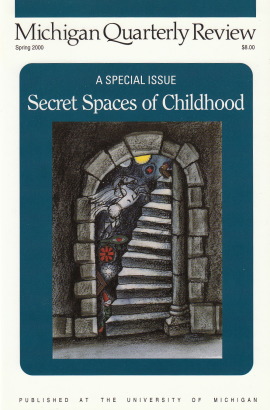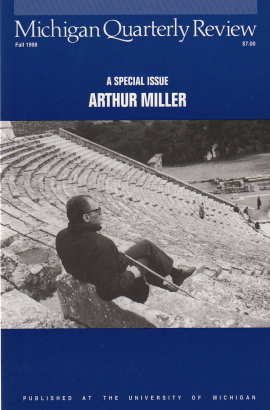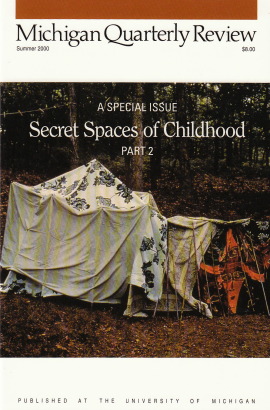Secret Spaces of Childhood, Vol. I
Edited by Elizabeth Goodenough
In this special issue, authors from a variety of fields explore the imaginative world of childhood, how children seek refuge from adult society in realms that paradoxically ease their way into adulthood, carrying with them the felt memories of transcendent and transgressive experience, sometimes wonderful, sometimes terrible.
Some of the highlights of the Spring issue include:
Nonfiction: Robert Coles, Professor of Psychiatry at Harvard and author of the ‘Children of Crisis’ series of books on modern American society, describes the candor and compassion of gravely ill children in his experience as a physician. Louise Chawla, member of a UNESCO committee to aid children around the world, describes how the children of squatter families in Johannesburg have coped with their hard lot, in part by imagining through artwork the brighter side to their perilous existence. Susan Engel examines how children use storytelling to fabricate secret worlds immune from adult control, and quotes some of the especially imaginative stories in complete form. Kathleen Faller, a national authority on child abuse, presents case studies, with commentary, to show how children are pushed into secret spaces that endanger their psychic wellbeing. Carolyn Gage considers the essential role of dolls in the development of adult behaviors, using her own career as a playwright as an example. Adrienne Kertzer compares the film Life is Beautiful with the texts, both literary and painterly, of Anita Lobel in order to study exemplary texts about the children of the Holocaust–in part by placing them in the context of our present knowledge about such children. James Christen Steward, Director of the University of Michigan Museum of Art, discusses the photography of Sally Mann, whose controversial nude and suggestive photos of her children have provoked a storm of controversy.
The issue also contains four lengthy memoirs that recreate and analyze the experience of secret spaces in childhood: Diane Ackerman, author of A Natural History of the Senses and A Natural History of Love among many other books, focuses on her first four years, recalled through the aid of hypnosis and a powerful memory. Uli Knoepflmacher, Professor of English at Princeton and the author of key books in the field of Victorian and children’s literature, including the recent Ventures into Childland, presents several episodes from his own childhood, citing literary affinities to each, and shows how they can be seen to form a virtually archetypal pattern explanatory of his identity. Thylias Moss, whose books of poetry have received honors (most recently a MacArthur Fellowship) and glowing reviews, recalls some of the experiences, especially with the choral music of African-American churches, that provided an escape from both everyday and extraordinary hazards during her childhood. Geoffrey O’Brien, author of The Phantom Empire, a book about film and spectatorship, and Dreamtime, about the 1960s, considers the way books saturate the imagination of a curious child and create habits of thinking and dreaming ever afterward.
Fiction: Fiction writers have presented the world with some of the most compelling evocations of childhood in our literature. In this issue Nicholas Delbanco contributes an autobiographical fiction about a three-year-old hidden away in England during the last year of World War II; and Karen Heuler tells a story of a girl who shares some secret time with the Devil, or so she tells the nuns in her Catholic school.
Poetry: Poets have always made childhood one of their privileged preserves. This issue features a new poem by Nobel Prize-winning man of letters Wole Soyinka on the anguish of the world’s children, as well as a signature poem by Nancy Willard. In addition, Laurence Goldstein recreates the theatre of imagery available to a dreamy child in the Life magazines of the 1940s and 1950s; Nobel Prize-winning chemist Roald Hoffmann, author of several books of poetry, thinks back to his ghetto experiences in Europe; Molly McQuade and Kurt S. Olsson summon the haunted imagination of the child, nourished as it is by fairy tale and ghost story; Cathy Song writes a hymn to children’s literature.
Reviews: Three book reviews round out the issue: Lois R. Kuznets contributes a review-essay on the Little House books about childhood by Laura Ingalls Wilder and her daughter Rose; Mark Spilka considers a new book exploring the worlds of Victorian childhood as imagined by John Ruskin, Lewis Carroll, Christina Rossetti, George MacDonald, and others; and Mitzi Myers considers new studies of childhood and adolescence in the 1990s that paint a dark picture of the fate of childhood in a violent society.
Graphics: A special feature of this special issue is a 16-page full-color portfolio of artwork by numerous contemporary artists featured at an exhibition in the Residential College of the University of Michigan. This is MQR‘s first full-color portfolio ever, introduced by Margaret Price, who comments on the artworks and on the general topic.



